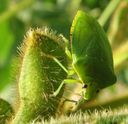Green Stink Bugs
Chinavia
Classification
- Phylum: Arthropoda
- Subphylum: Hexapoda
- Class: Insecta
- Order: Hemiptera
- Suborder: Heteroptera
- Infraorder: Pentatomomorpha
- Superfamily: Pentatomoidea
- Family: Pentatomidae
- Subfamily: Pentatominae
- Tribe: Nezarini
- Genus: Chinavia
Pronunciation
How to pronounce Chinavia: //kɪˈna.vɪ.a//
These audio files are automatically generated. While they are not always 100% accurate, they are a good starting point.
Images






Summary
Chinavia is a genus of stink bugs, commonly referred to as green soldier bugs, including the well-known green stink bug, Chinavia hilaris. They are notorious pests of agricultural crops, particularly noted for causing damage through their feeding habits.
Physical Characteristics
Typically bright green, with narrow yellow, orange, or reddish edges; large, shield-shaped bug with an elongate, oval form; length between 13 and 18 mm. Black outermost three antennal segments; anterolateral pronotal margin is straight and not strongly arced; large stink glands on underside of thorax extending to edge of metapleuron.
Identification Tips
Antennal color can help to separate Chinavia marginata and Chinavia hilaris in the eastern US; however, this character may be less reliable in regions west of Texas.
Habitat
Found in orchards, gardens, woodlands, and crop fields throughout North America, often found on various crops and noncrop host plants.
Distribution
Ranges from New England to Florida in the eastern United States and exists along the west coast from San Diego, California to Seattle, Washington.
Diet
Feeds on juices from leaves, fruit, and flowers of a wide variety of plants from 36 families recorded worldwide; specifically, it damages plants like tomato, bean, pea, cotton, soybean, and various fruit trees.
Life Cycle
Adults appear in the field early September, mating occurs in October, and eggs can be found mid to late October. Nymphs appear in late October and early November; two or three generations occur in summer months depending on location.
Reproduction
Adult females attach keg-shaped eggs on the underside of foliage in double rows of twelve or more; eggs transition in color from light green to yellow to light pink before hatching, which is influenced by temperature.
Predators
Parasitized by the tachinid fly Trichopoda pennipes and various parasitic wasps.
Ecosystem Role
Acts as a pest of economic importance, impacting various crops through feeding.
Economic Impact
Considered a pest in the United States; damages crops by splitting plant tissue and causing deformity, internal warts in cotton, green stem syndrome in soybeans, and blemishes on fruits like peaches and tomatoes.
Evolution
Previously regarded as belonging to the genus Acrosternum; classified as Chinavia in more recent literature despite still being officially recognized under Acrosternum by the Entomological Society of America.
Tags
- Chinavia
- Green Stink Bugs
- Pentatomidae
- Agricultural Pests
- Insecta
- Hemiptera